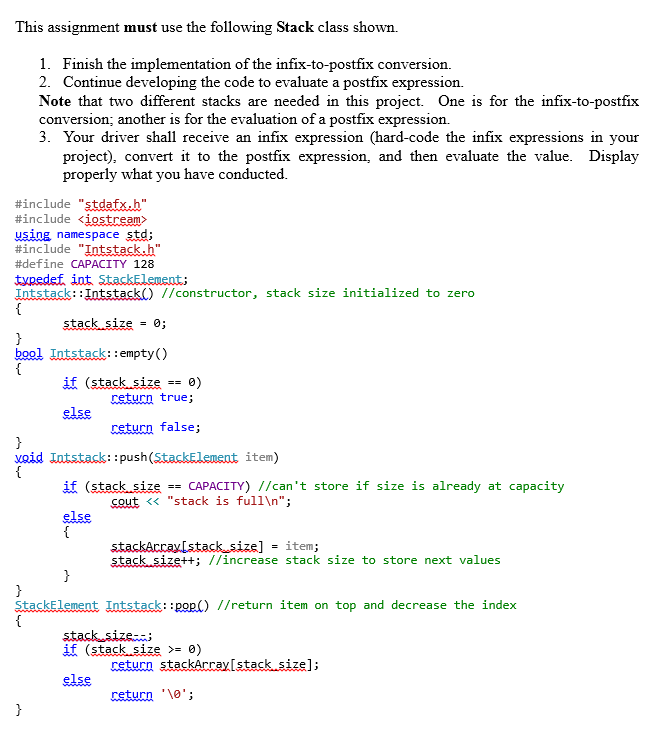In C++, use the following Stack class shown to convert from INFIX to POSTFIX and generate another stack to Evaluate that POSTFIX expression.

This assignment must use the following Stack class shown. 1. Finish the implementation of the infix-to-postfix conversion. 2. Continue developing the code to evaluate a postfix expression. Note that two different stacks are needed in this project. One is for the infix-to-postfix conversion; another is for the evaluation of a postfix expression. 3. Your driver shall receive an infix expression (hard-code the infix expressions in your project), convert it to the postfix expression, and then evaluate the value. Display properly what you have conducted #include "stdafx.h" #include iostream using namespace std; #include "Intstack.h" #define CAPACITY 128 typedef int StackElenent; Intstask: IntstackO //constructor, stack size initialized to zero stack. size - 0; bool Intstack: :empty () if (stack.size -- 0) true; else return false; void Intstack: :push (StackElement item) if (stack sizeCAPACITY)//can't store if size is already at capacity cout"stack is full "; else - item; stack sizett; //increase stack size to store next values StackElement Intstack: :pop() //return item on top and decrease the index if (stachk return stackArray[stack size]; else This assignment must use the following Stack class shown. 1. Finish the implementation of the infix-to-postfix conversion. 2. Continue developing the code to evaluate a postfix expression. Note that two different stacks are needed in this project. One is for the infix-to-postfix conversion; another is for the evaluation of a postfix expression. 3. Your driver shall receive an infix expression (hard-code the infix expressions in your project), convert it to the postfix expression, and then evaluate the value. Display properly what you have conducted #include "stdafx.h" #include iostream using namespace std; #include "Intstack.h" #define CAPACITY 128 typedef int StackElenent; Intstask: IntstackO //constructor, stack size initialized to zero stack. size - 0; bool Intstack: :empty () if (stack.size -- 0) true; else return false; void Intstack: :push (StackElement item) if (stack sizeCAPACITY)//can't store if size is already at capacity cout"stack is full "; else - item; stack sizett; //increase stack size to store next values StackElement Intstack: :pop() //return item on top and decrease the index if (stachk return stackArray[stack size]; else







